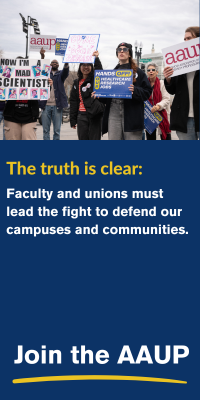- About
- Programs
- Issues
- Academic Freedom
- Political Attacks on Higher Education
- Resources on Collective Bargaining
- Shared Governance
- Campus Protests
- Faculty Compensation
- Racial Justice
- Diversity in Higher Ed
- Financial Crisis
- Privatization and OPMs
- Contingent Faculty Positions
- Tenure
- Workplace Issues
- Gender and Sexuality in Higher Ed
- Targeted Harassment
- Intellectual Property & Copyright
- Civility
- The Family and Medical Leave Act
- Pregnancy in the Academy
- Publications
- Data
- News
- Membership
- Chapters
From the Editor: Spotlighting the Faculty
As faculty members, we tend to put more faith in our words than our actions. Our scholarship and teaching, we believe, speak for us, validating our position within society. Sometimes, however, this leaves us looking weak where others appear strong. Nonacademics are taking the central place in the public spotlight even in arenas of great concern to academia, ones where the faculty should be on center stage.
To change that, we have to become our own advocates. Joining the AAUP, of course, is a first step, but each of us needs to do more. We should shape the public perception of the faculty; we should shine a light on ourselves. Too often, administrators, politicians, journalists, and think-tank pundits have a greater impact on how people see us than we do ourselves.
This issue of Academe starts with a quartet of articles assembled and initially edited by Martin Kich, a professor and AAUP activist at Wright State University, an editor of Academe Blog, and a member of the Academe editorial advisory board. The first of these articles, by John K. Wilson, who is also an editor of Academe Blog, argues that we must be more alert to changing media in our struggle to protect academic freedom. Wilson’s article is followed by a piece by Peter N. Kirstein, chair of the Illinois AAUP’s Committee A on Academic Freedom and Tenure, analyzing the media’s coverage of the Steven Salaita case. The third article, by Kich himself, explores the unfolding situation surrounding tenure in Wisconsin. In the article that follows, Greg Loving and Jeff Cramerding offer advice to faculty members dealing with the media. Together, these four articles both paint a stark picture of the way academia’s issues are presented in the media and tell us how we might more effectively influence the public perception of faculty issues.
Academe Blog is one place where faculty have such influence. Since its establishment in 2011, the blog has had over 1 million views, making it, along with this magazine and the Journal of Academic Freedom, an important part of the AAUP’s public activities. Relying on the immediacy of the Internet and social media, the blog allows AAUP members to respond publicly and quickly to events relating to academia. It was instrumental in bringing attention to the case of Salaita, in part because of posts by Wilson and Kirstein.
The features section concludes with three articles on other topics of concern to faculty. We in academia often pride ourselves on our forthright confrontation of bias, but confronting bias is not so simple—nor are we as effective as we might believe, as Marie Chisholm-Burns tells us in an article about unconscious bias. Her article is followed by Lorna Fitzsimmons’s “Liberal Arts in the Modern University,” another in our ongoing series of essays arguing for the importance of a traditional focus on the liberal arts. The final article, by Howard V. Hendrix, looks at modern student attitudes toward education and teachers.
Visit Academe on the web to read an additional online-only article by Alberto Hernandez-Lemus and to comment on the contents of this issue.



